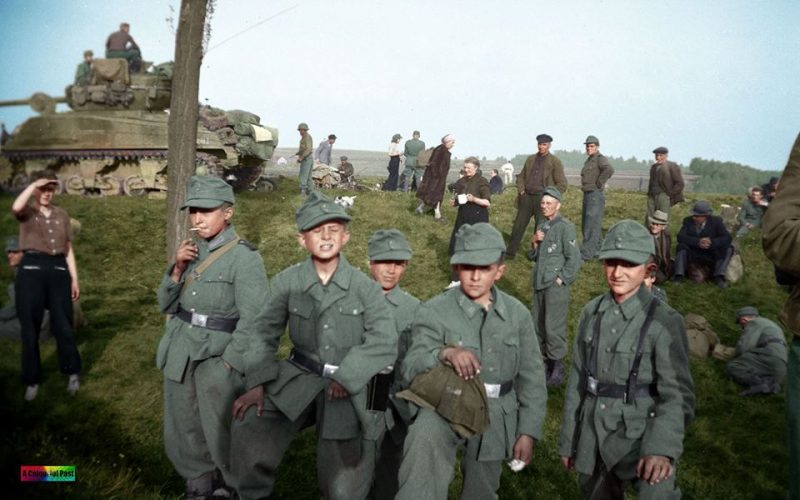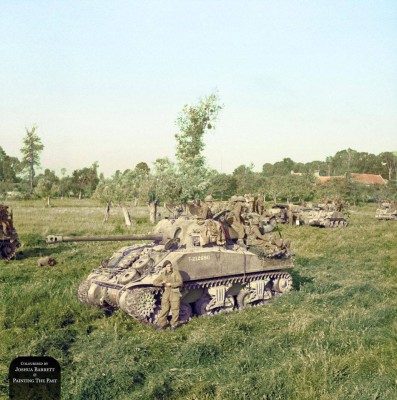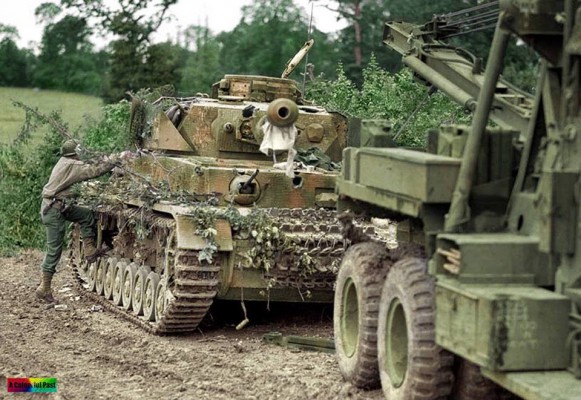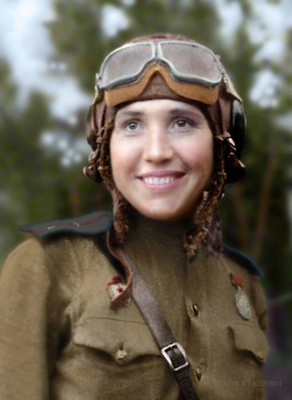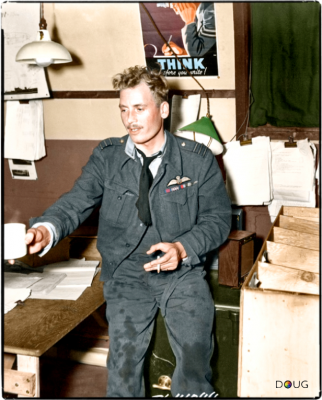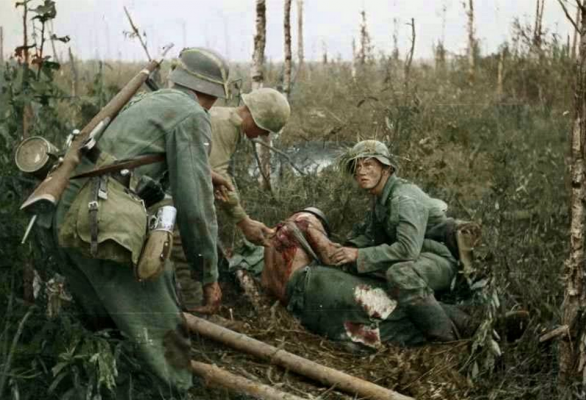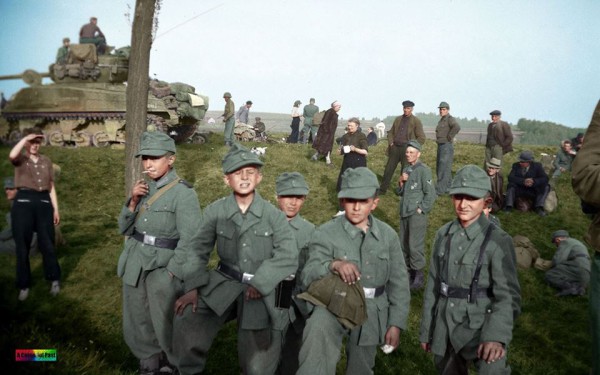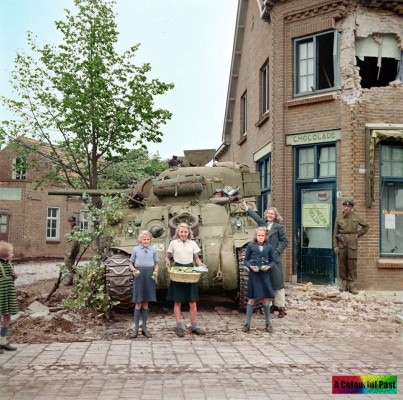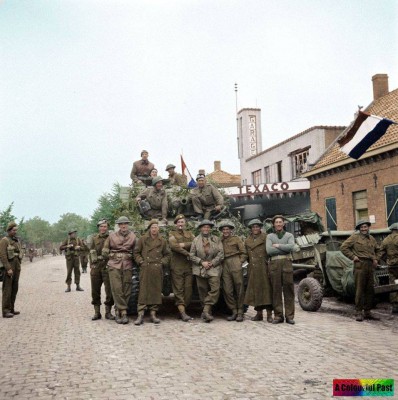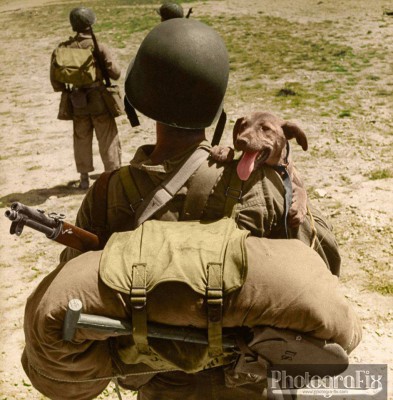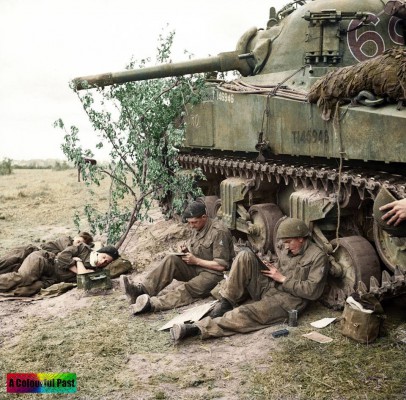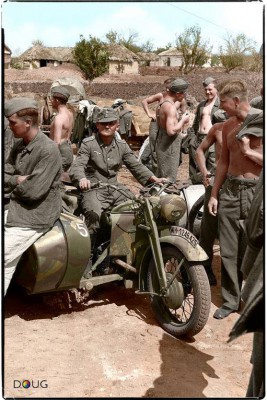Many thanks go to Doug Banks and his team – the masters of colourisation. The beauty of these colourised images is that colour, allows you to pick out and study the smallest detail. This makes these 100 year old images ‘alive’. Do not click on their page – you will become addicted to their work It is the research that they do on each image that makes the captions themselves a history lesson.
Sherman Firefly Vc T212680 ‘Belvedere’ of “B” Squadron, Staffordshire Yeomanry, 27th Armoured Brigade, along with other armour and infantry prior to the commencement of ‘Operation Goodwood’ on the morning of 18th July, 1944.
On 16th July the Staffordshire Yeomanry moved across the River Orne and on the 18th the attack went in. It was preceded by a heavy air raid on the enemy gun positions by 450 aircraft of the Tactical Air Force. “C” Squadron was attached for the first phase of the operation to 13th/18th Hussars and given the task of passing through them as soon as they had reached and consolidated their objective, the village of Butte de la Hogue. Shortly after the finish of the air raid the barrage was begun, and fifteen minutes later, as it lifted, 3rd Infantry Division, supported by 27th Armoured Brigade, began their advance. The armour of 13th/18th Hussars quickly reached Butte de la Hogue and “C” Squadron passed through, making a dash across the plain as far as the lateral railway line in the south, which was their objective. They lost two tanks during the process, knocked out by an anti-tank gun at Lirose.
“A” and “B” Squadrons advanced on the left of the main axis, mopping up pockets of resistance and engaging tanks and anti-tank guns. They finally reached Lirose, where they engaged a number of enemy strong-points in a concentrated shoot. Two Shermans of “B” Squadron were lost when hit by anti-tank fire. Major Turner and Lieutenant Elks being wounded. Corporal Steer was killed during the advance and fourteen other ranks were wounded.
Although Falaise was not reached, because of the stiffening opposition in the closely wooded country beyond the railway line, the operation had been partially successful. The whole area of the break-through was consolidated and formed a solid base for further British and Canadian attacks on Falaise, which was finally to fall on 16th August, almost simultaneously with the reaching of Argentan by the Americans.
The Staffordshire Yeomanry spent a number of days in this area, concentrated in the neighbourhood of Butte de la Hogue. Their task was to hold the two villages of Le Preaux and Cagny in the south of the salient, and their time was spent in mopping-up and carrying out a number of patrols to assist the infantry in clearing the extensive woods on the left flank. During most of the time they were subjected to fairly heavy artillery and mortar fire, but escaped without further casualties.
(Source – IWM B 7513 – Sgt. Laing No 5 Army Film & Photographic Unit) (Colourised by Joshua Barrett from the UK)
https://www.facebook.com/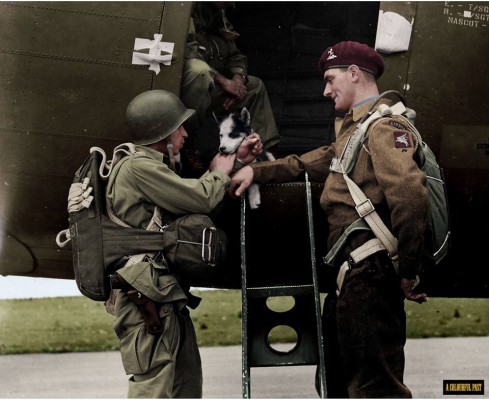
En route to England, the men of the 2nd Battalion, 503rd Parachute Infantry found and rescued this pup, Smokey, seen here in Iceland.
The troops brought him to England, and he’s seen here with one of the 503rd’s members as he chats with Lt. John Timothy, the British liaison officer to the 2/503. The 503rd was the first American ground unit to reach England after Pearl Harbor. There is some confusion over 2/503rd’s history these days. The battalion took part in Operation Torch and executed the U.S. Army’s first combat jump. During the African campaign, however, the Army re-designated 2/503rd to the 509th Parachute Infantry. Apparently, the members of the battalion didn’t get that memo until after the war. Meanwhile, a new 503rd Parachute Infantry Regiment was formed and sent to the Pacific, where it joined the 11th Airborne Division and took part in the New Guinea and Philippines Campaign. That 503rd made the jump on Corregidor in February 1945.
(Colourised by Allan White from Australia) https://www.facebook.com/
Panzerkampfwagen Pz. IV Ausf. J, tactical number 6×5, from 6./SS-Pz.Rgt.2, knocked out by the 2nd Battalion/US 117th Infantry Regiment of the 30th Infantry Division on the outskirts of St. Fromond, Normandy, 9th July 1944.
At the time the 117th was supported by the 743rd Tank Battalion and the 823rd Tank Destroyer Battalion (M10). The Pz. IV is being hauled away by an M1A1 Heavy Wrecker of an unknown unit. (Nb. The Pz. IV had the Fahrgestellnummer (chassis number) 89689.)
(Researched material supplied by John Winner) (Colourised by Allan White from Australia) https://www.facebook.com/
Soviet Fighter pilot Lt. Antonina Lebedeva (1916-1943)
Before the war, she studied at the Moscow State University and had been an instructor of one of the capital’s flying clubs. Her military career began in the women’s 586th Fighter Regiment, protecting the sky of Saratov. Later she was transfered to the 65th Guards Fighter Regiment.
On January 10, 1943 in an air battle, Lebedev was alone against two enemy fighters. She bravely went into battle with them and destroyed one Bf-109. Her aircraft suffered serious damage but she was able to make a safe, forced landing. During the Orel-Kursk operation, on July 17, 1943 in an unequal battle of four Yak-9 against numerous enemy aircraft, she was shot down and her fate remained unknown.
In 1982 near the village of Betovo, Oryol Region, a plane was excavated, that had crashed in the summer of 1943. The remains of the pilot, a parachute, a pistol, a knife and documents were found. Among the documents were the flight and medical books, where clearly was written the name of the holder: Antonina Lebedeva. In the remains were also found a headset with fragments of a skull and two girlish pigtails.
(Colorised by Olga Shirnina from Russia)
https://www.facebook.com/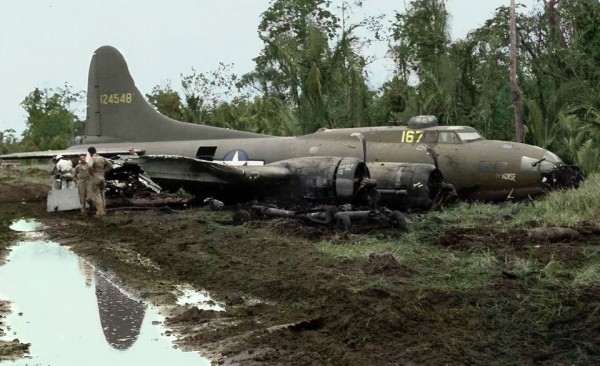
B-17F-25-BO “Harry the Horse” S/Nº 41-24548 Field Nº 167
Tadji Airfield, West Sepik Province Papua New Guinea. May 1944 #B17
On May 4, 1944, this B-17 took off from Nadzab Airfield, Morobe Province in PNG, piloted by Lt. Robert Kennedy (no relation) on a mission to drop supplies over Hollandia. Returning, the bomber ran short of fuel and attempted to land at Tadji Airfield. During the landing at 12:00K, the right wheel collapsed, causing the B-17 to skid off the runway in a “wild run” that ended “within the limits of a bomb dump”. The B-17 sustained damage to the outer wing. Beyond repair, the wreckage was stripped for parts and partially disassembled from the wings and abandoned in a bone yard area.
(pacificwrecks.com)
Wartime History;
Assigned to the 43rd Bombardment Group, 403rd Bombardment Squadron. This B-17 operated from northern Australia and 7 Mile Drome near Port Moresby during 1943. Later, assigned to the 63rd Bombardment Squadron and later the 64th Bombardment Squadron. This B-17 had tiger stripes painted on the tail and girl’s names on the outer engine cowling including “Mary” on the number 4 engine.
During 43rd Bombardment Group service, the nose section of a B-17E added, with reinforced mount for a .50 caliber machine gun in the center of the nose.
The last mission this B-17 flew with the 43rd Bombardment Group was on October 10, 1943, piloted by Captain Jack L. Campbell on an early morning weather reconnaissance over Rabaul.
During early November 1943, converted to an armed transport at the 4th Air Depot at Garbutt Field. Afterwards, assigned to the 54th Troop Carrier Wing, 375th Troop Carrier Group, 57th Troop Carrier Squadron as an armed transport and operated from Port Moresby and Nadzab Airfield.
In Troop Carrier service, the B-17 was completely repainted with a new coat of olive drab paint and nicknamed “Harry the Horse”. Assigned field number “167” painted in yellow on both sides of the cockpit, behind the co-pilot’s window. On the outer side of the No. 4 engine cowl was painted “Betty Jo” with a heart. Another name was painted on the No. 3 engine cowl. (pacificwrecks.com)
Colourised by Allan White from Australia) https://www.facebook.com/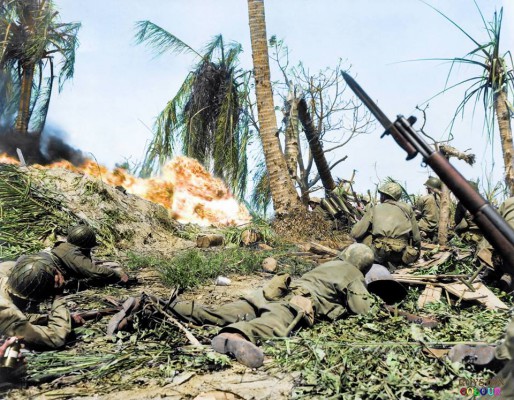
Men of the US 7th Infantry Division using flame throwers to smoke out Japanese from a block house on Kwajalein Island, while others wait with rifles ready in case they come out. February 4, 1944.
Battle of Kwajalein:
Designated ‘Operation Flintlock’, the Allied plan called for Rear Admiral Richmond K. Turner’s 5th Amphibious Force to deliver Major General Holland M. Smith’s V Amphibious Corps to the atoll where Major General Harry Schmidt’s 4th Marine Division would assault the linked islands of Roi-Namur while Major General Charles Corlett’s 7th Infantry Division attacked Kwajalein Island. To prepare for the operation, Allied aircraft repeatedly struck Japanese airbases in the Marshalls through December. Moving into position, US carriers began a concerted air offensive against Kwajalein on January 29, 1944.
Two days later, US troops captured the small island of Majuro, 220 miles to the southeast, without a fight. That same day, members of the 7th Infantry Division landed on small islands, dubbed Carlos, Carter, Cecil, and Carlson, near Kwajalein to establish artillery positions for the assault on the island. The next day, the artillery, with additional fire from US warships, opened fire on Kwajalein Island. Pummeling the narrow island, the bombardment allowed the 7th Infantry to land and easily overcome the Japanese resistance. The attack was also aided by the weak nature of the Japanese defenses.
The victory at Kwajalein broke a hole through the Japanese outer defenses and was a key step in the Allies’ island-hopping campaign. Allied losses in the battle numbered 372 killed and 1,592 wounded. Japanese casualties are estimated at 7,870 killed/wounded and 105 captured. In assessing the outcome at Kwajalein, Allied planners were pleased to find that the tactical changes made after the bloody assault on Tarawa had bore fruit and plans were made to attack Eniwetok Atoll on February 17. For the Japanese, the battle demonstrated that beachline defenses were too vulnerable to attack and that defense in-depth was necessary if they hoped to stop Allied assaults.
(militaryhistory.about.com)
(Source – The US Army – NARA FILE #: iii-SC-212770 WAR & CONFLICT BOOK #: 1187)
(Colourised by Royston Leonard UK)
https://www.facebook.com/
Wing Commander Alfred ‘Ken’ Gatward after his return from leading an anti-shipping operation with 404 “Buffalo” Squadron RCAF.
With coffee and cigarette in hand, hair disheveled and oil stains on his battle trousers.
This photo was reputedly taken after Gatward’s final op with 404. Note that his tie has been clipped in honour of the occasion and that it’s possible the cup does not contain coffee as he seeks a refill. (vintagewings.ca)
‘Dropping a huge French flag on top of the Arc de Triomphe’
RAF pilot Flight Lieutenant Ken Gatward and his navigator, Flight Sergeant George Fern, volunteered for the audacious mission, which was planned following intelligence reports that German troops were parading down the Champs-Elysees every day between 12.15 and 12.45 pm.
On 12 June 1942 Gatward and Fern took off in their Bristol Beaufighter from Thorney Island, West Sussex, flew over the English Channel into occupied France and headed towards Paris at low level. Gatward later recalled, “I’ll never forget the astonishment of the crowd in the Paris streets as we swept low at rooftop level. They had been taken completely by surprise.”
Gatward flew at just 30ft down the Champs-Elysees and Fern dropped the French Tricolour on top of Paris’ famous monument. Gatward then flew on to the Gestapo’s Paris HQ, the former Ministere de la Marine, raked it with 20mm shells – scattering its SS guards in panic – and Fern dropped a second Tricolour on the building. The daring duo’s spectacular raid boosted the morale of oppressed Parisians and, when the news broke at home, lifted the spirits of the beleaguered British too. Gatward was awarded the Distinguished Flying Cross and both he and Fern were feted as heroes.
London-born Gatward, who had joined the RAF Volunteer Reserve in 1937 and started the war as a sergeant pilot, went on to command No 404 Sqn, Royal Canadian Air Force. In August 1944 he led the Sqn on a raid against enemy shipping in Norwegian waters which earned him a second DFC. He also earned the Distinguished Service Order the same year.
Ken Gatward retired from the regular RAF as a Group Captain in 1967, then immediately rejoined the RAF Volunteer Reserve as an instructor in the rank Flight Lieutenant, enabling his return to his first love – flying. He died in 1998 aged 84. (abroadintheyard.com)
(Photo via 404 Squadron site)
(Colourised by Doug) https://www.facebook.com/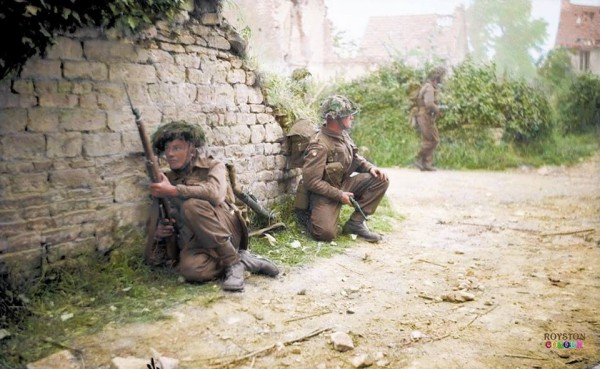
Men of 12 Platoon, ‘B’ Company, 6th Battalion, Royal Scots Fusiliers, 15th (Scottish) Division, take cover in Saint-Manvieu-Norrey in Calvados, during ‘Operation Epsom’, 26 June 1944.
“The thin rain and fog were to mix with the smoke and dust from the barrage to create a fog bank in places. Aircraft in Britain were kept grounded by poor visibility so British forces were without one of their major advantages. As the barrage fell they moved forward to their start line, ahead of them the Royal Scots Fusiliers had begun the attack …..” (Robert Woollcombe, platoon commander with the King’s Own Scottish Borderers (K.O.S.B.).
On 26th June, Montgomery launched ‘Operation Epsom’, a major attack aimed at the town of Caen, the major obstacle to British expansion in the east of the Normandy battlefield. The attack was led by the 44th (Lowland) Infantry Brigade and the 46th (Highland) Infantry Brigade of the 15th (Scottish) Infantry Division with a number of famous regiments taking part including the Royal Scots, the Royal Scots Fusiliers, the Cameronians, the Seaforth Highlanders and the Gordon Highlanders.
(IWM Non Commercial Licence – B 5967 – No 5 Army Film & Photographic Unit)
(Colourised by Royston Leonard UK)
https://www.facebook.com/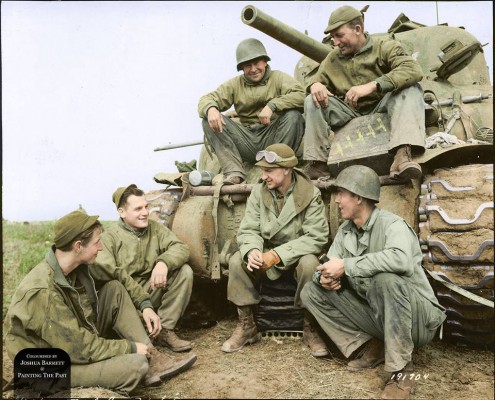
American Journalist and War Correspondent, Ernie Pyle (centre) converses with the crew of a Sherman tank belonging to 191st Tank Battalion at the Anzio Beachhead in 1944.
Upon the outbreak of the Second World War, Ernie Pyle took his journalistic talents to the battlefields of Europe and the Pacific as a War Correspondent. His intimate focus on the common soldier and his reportage of their experiences and perspective stood out for the crowd. Ernie Pyle was writing about the experiences of the ‘everyman’ while others were reporting on the actions of generals and battle plans. It was this approach to War Correspondence that earned Mr.Pyle his Pulitzer Prize in 1944.
A column written by Ernie Pyle in 1944 urging that Soldier’s should earn a fair ‘fight pay’ wage for their service, successfully convinced Congress to pass a law authorizing an additional $10 extra pay for Infantrymen. Due to his pivotal role in securing this wage increase it was dubbed ‘The Ernie Pyle bill’.
Ernie Pyle was killed by enemy machine-gun fire on the island of Iejima, near Okinawa. 18 April, 1945.
(Colourised by Joshua Barrett from the UK)
https://www.facebook.com/
The Battle of Wolchow (Volkhov) near Lake Ladoga (Leningrad) in July 1943. (Nb. Yes, we do know the Soviet soldier has his helmet on back to front)
By utilizing the help of a Russian prisoner with medical knowledge, the Wehrmacht Sanitäter gives first aid to a wounded soldier in battle. They are seen using an improvised stretcher to take him to a dressing station at the rear, to get more treatment. The location is in the swamp area of Lake Ladoga (northern Russia) which became a fierce battleground in the month of July 1943.
“I think it was the 3rd of July 1943. Another hour later we had reached the slopes of the foot of the Heights of Patschino. No one made a sound, it was completely silent. We were to attack without any artillery support which I think was a mistake. Its was pitch dark and we could barely see the details of the slope in front of us. The frst group fanned out and started its advance, our group following behind. First our plan seemed to be a great success, we had take the Soviets by suprise. The first and second line of trenches were taken in hand-to-hand combat. From my position in second group I could see the flamethrowers to their work. A gruesome sight, bright jets of flame illuminating thick oily clouds of smoke. My group now entered the trenches the first group had taken and set up our machine guns to be able to repel the expected soviet counter-attack.
Initially we had attacked with over 500 men. Believe me, at this moment there were no more than 100 still alive. I fell back towards the main force. When I arrived I met two soldiers of my company, which was down to only 5 men! All officers and NCOs had been wounded or killed which effectualy gave me command of the company. Together with my two comrades we fled. We ran like hares. Mortar and artillery shells exploding around us, bullets whistling around our ears. I will never forget the sights of that hellish inferno. I was running and jumping over the dead bodies of my fallen comrades which seemed to lying everywhere, when a mortar shell exploded next to me. I dont remember a lot of what followed but some splinters had hit my face and arm. I was nearly deaf from the explosion and must have passed out. I woke at the main dressing station. My two comrades had carried me back, all the way. I am glad that all this over. War is such a terrible thing.”
(Herr Gustav Römer – IR506 of the 291st Division)
(Photo by SS-Kriegsberichter Wisniewski, Nord 1942-1943, Brigade Nederland 1944, holder of the Iron Cross II)
(Colorised by Bill at Wwiicolor Izer)
https://www.facebook.com/profile.php?id=100009263287356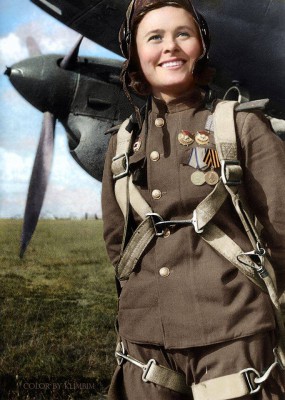
Maria Dolina (1922–2010) was a Soviet pilot and acting squadron commander of the 125th “Marina M. Raskova” Borisov Guards dive bomber Regiment.
She was active primarily on the 1st Baltic Front during World War II, performing 72 sorties in the Pe-2 Petlyakov light bomber, dropping a total 45,000 kg bombs. In six aerial combats Maria and her crew shot down 3 enemy fighters (in the group). On August 18, 1945 Dolina was awarded the title of the Hero of the Soviet Union.
(Colorised by Olga Shirnina from Russia)
https://www.facebook.com/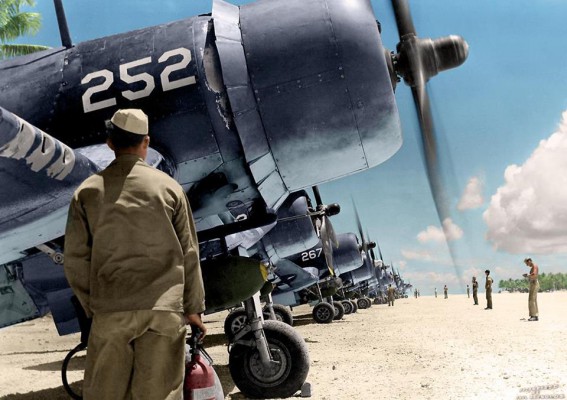
F4U-1 Corsair #252 (possibly that of 1/Lt. William ‘Bill” Boshart) VMF 224, Marine Corps 4th Marines Aircraft Wing, Majuro Airstrip, Marshall Islands. Planes being readied for fighter patrol due to radar picking up Japanese bombers headed for the Palau Island group, Peleliu, September 19th 1944.
4th Marine Air Wing headquarters & Marine Air Group 13 relocated to Majuro Atoll in mid-March 1944.
Units stationed at Majuro included VF-39 operating the F6F Hellcat, VMF-155 & VMF-224 operating F4Us & VMSB-231 operating SBDs.
Colourised by Paul Reynolds.
Colourised version © copyright Paul Reynolds.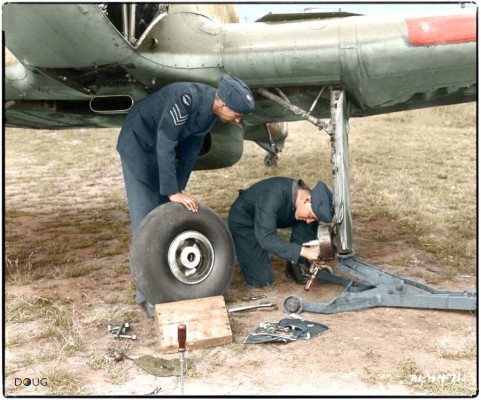
The often forgotten Squadron Ground Crew
Members of No.1 Squadron RCAF ground crew tend to a Hawker Hurricane. While Leading Aircraftman P.J. Thurgeon removes the port wheel, because of faulty brakes, Sergeant Bob Fair checks to see if the craft should go into maintenance to be repaired. Often forgotten, No.1’s ground crew worked tirelessly to keep the aircraft in good repair; without them the squadron could not have flown.
July 1941.
(Nb. Red fabric patches were doped over the gun ports in order to prevent moisture (rain or fog) from entering the open gun ports in the wing and freezing on the gun breeches as the plane took off and climbed rapidly into the colder air.The first bullet simply cut a hole in the tape. Armorers usually left taping over the gun ports to the last, after they had cleaned and reloaded the guns, so the intact red patches were a sign that the fighter was ready for action again.)
(PHOTO: Courtesy Library and Archives of Canada)
“These young German soldiers, likely taken directly from the rank of a local Hitler Youth group, were captured somewhere outside of Leipzig Germany in May of 1945. The recent discovery of a 600+ negative grouping from a chaplain in the US 9th Armored Division yielded this gem of an image. The emotion and raw sadness of the war can be seen in the eyes of the boy smoking the cigarette in the left side of the photo. They can’t be more than eight or nine years old.”
(Colourised by Allan White from Australia) https://www.facebook.com/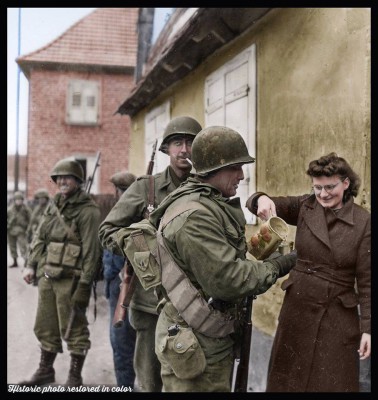
American Soldiers from the 2nd Battalion, 314th Infantry Regiment-79th Infantry Division receive wine from French civilians during a lull in the fighting around Drusenheim, France on January 6, 1945.
On 6 January, at 0830, the 2nd BN, supported by a company of 749th tanks, moved out to Rohrwiller. Foggy conditions provided excellent cover, the objective was met and the town under 314th’s control by 0100. The attack drive was ordered forward to take Herrlisheim. Word reached the 314th elements that A/Co 232nd Infantry was in trouble in Drusenheim. 2nd BN was to clear and secure the town en route to Herrlisheim. 3rd BN was called from Bischwiller to Rohrwiller as the 2nd moved out. At 1400, G/Co riding on its tank support, entered the northwest side of Drusenheim. After meeting up with elements of 232nd’s A/Co, 2nd BN moved its units under small arms fire across the Moder River bridge to clear and secure the southern part of town. Five tanks managed to clear the bridge before it broke down. The tanks then accompanied F/Co, on point, on the attack southwest of Herrlisheim. At 1630, as F/Co reached the outskirts of Drusenheim, it met light artillery fire. F/Co attacked the enemy’s strong point – a factory building on the east bank of the Moder – capturing two officers and 51 enlisted men. The rest of the 2nd BN were in positions in or around Drusenheim.
As the 3rd BN moved up the take over positions in Rohrwiller, it fell under the heaviest artillery barrages it had faced to date. During the night of 6-7 January, the bridge in Drusenheim was repaired in the midst of constant enemy fire. I&R and Cannon were outposting Bischwiller alone, because the 1st BN was still away on the Zinswiller mission.
(Colorised by Johhny Sirlande from Belgium)
https://www.facebook.com/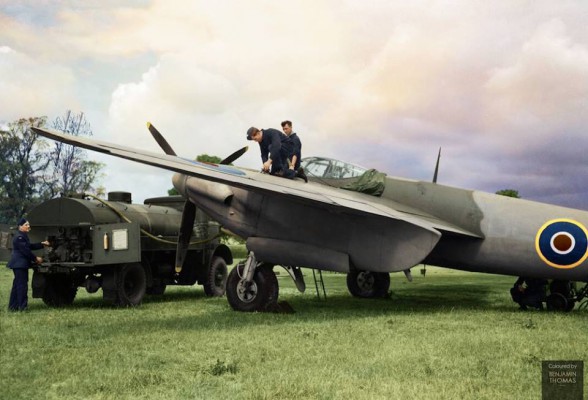
De Havilland Mosquito Mk II of No. 157 Squadron RAF refuelling at Hunsdon, Hertfordshire. 16 June 1943
No. 157 Squadron was the first squadron to use the Mosquito as a night fighter, reforming on 13 December 1941 specifically to operate the type (after a short incarnation towards the end of the First World War).
The first patrols were flown on the night of 27-28 April 1942 over East Anglia but the first confirmed kill did not come until 22/23 August 1942.
As the threat from German bombers faded, No. 157 squadron received a number of Mosquito FB.Mk VIs, and began to fly intruder missions over occupied Europe. In November 1943 the squadron moved to Cornwall and increasingly concentrated on the intruder role. After a brief interlude flying defensive patrols over the Irish Sea, in May 1944 the squadron moved to East Anglia, where it joined No.100 Group and carried out intruder missions to support the heavy bombers.
(Source – IWM Non Commercial Licence – CH 10312 P/O H V Drees, Royal Air Force official photographer)
(Colourised by Benjamin Thomas from Australia)
https://www.facebook.com/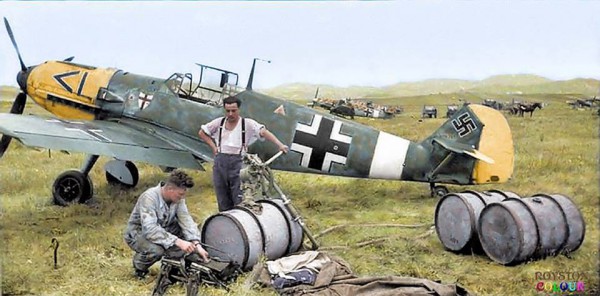
A poor quality but very rare photo. (to those in the know about Bf.109s)
Ground operations around a Messerschmitt Bf 109E-7 of the Luftwaffe’s Jagdgeschwader 27 (JG27) possibly during it’s brief operational spell in Gela, Sicily between the 3rd and 24th of May 1941. During its stay in Sicily, III./JG27 operated over Malta.
The 109 has still got the original JG27’s emblem used prior to the move to North Africa. The 109s in the background seem to have a North African camouflage. This is the first time we’ve seen the rank markings displayed on the nose instead of close to (before or after) the fuselage’s Balkenkreuz. In this case the rank seems to be that of a Geschwader Adjutant (Wing Second-in-Command).
The markings on the engine cowling are characteristic of III./JG27 and were inherited from the Gruppe’s predecessor, I./JG1.
(Researched by Doug and Rui) (Colourised by Royston Leonard UK)
https://www.facebook.com/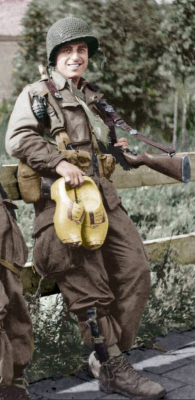
Technician Fourth Grade Frank J. Perconte, a non-commissioned officer of Easy Company, 2nd Battalion, 506th Parachute Infantry Regiment, 101st US Airborne Division, holding a pair of Dutch Clogs and leaning on a fence along the Dommel River on Bleek Straat, Eindhoven in the Netherlands.
September 1944.
With his comrades in Easy Company, Frank Perconte made a harrowing jump into Normandy before U.S. forces landed on the beaches on D-Day ’44 He also saw action in the Netherlands during Operation Market Garden and was wounded by a German sniper in the town of Foy during the Battle of the Bulge on January 13 1945.
After a few days, he rejoined Easy Company in the town of Haguenau for the occupation of Germany.
(March 10, 1917 – October 24, 2013, aged 96) (Colorised by Leo Determann from the Netherlands)
https://www.facebook.com/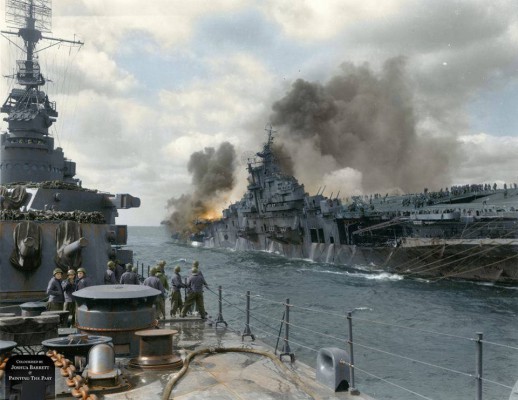
Cleveland-class Light Cruiser, ‘USS Santa Fe’ CL-60 pulls alongside Essex-class Aircraft Carrier, ‘USS Franklin’ CV-13 as it lists towards its starboard side after suffering two direct hits from a pair of armour piercing bombs, dropped by a lone Japanese plane. Near Okinawa. 19th March, 1945.
Sea calm, 12-knot wind from about 060 true, sky overcast with occasional breaks, horizontal visibility excellent. At approximately 0707hrs on 19th March, 1945, ‘USS Franklin’ suffered two direct hits from a pair of 500lb bombs dropped by a lone Japanese Yokosuka D4Y ‘Judy’ dive bomber.
The first of the two armour-piercing bombs penetrated down to the hanger deck, destroying aircraft and igniting fires across decks two and three. The Combat information Centre and Air Plot were also knocked out by this bomb. The Second bomb tore down through two decks, detonating bombs and ammunition and igniting fuel stored below the flight deck.
The ‘USS Franklin’ was soon set ablaze, the 26,000 ton ship rocked by secondary explosions as aircraft both on and below deck burst into flames along with huge quantities of ammunition. The surviving crew sought refuge on the forward flight deck, many taking action in an attempt to fight the fires that were tearing through the ship. The ‘USS Santa Fe’ drew close alongside the stricken Carrier despite the massive explosions erupting from its deck and partook in fire-fighting as well as the rescue of hundreds of endangered crewmen.
It took three hours to get the fires on board ‘USS Franklin’ under control but miraculously the ship remained afloat. It was towed by ‘USS Pittsburgh’ to Ulithi from which it continued on to Pearl Harbour under her own power, escorted by ‘USS Santa Fe’. 724 crewmen of the ‘USS Franklin’ lost their lives in the single attack and 265 were wounded. The ‘USS Franklin’ became the most heavily damaged Aircraft Carrier of the War and was decommissioned in 1947.
(Colourised by Joshua Barrett from the UK)
https://www.facebook.com/
Local girls giving apples to a Sherman crew outside of a Bakery in Aalst, Holland. 18 September, 1944,
2nd Armoured Battalion of the Irish Guards, 5th Guards Brigade, Guards Armoured Division, 30 Corps.
The ultimately unsuccessful week-long ‘Operation Market Garden’ commenced on September 17, 1944 with an Allied push toward Germany. The ground portion of the campaign saw the British Guards Armoured Division taking point on the push into the Low Countries.
On the second day of the operation, a column of the Guards Armoured had rolled to the southern outskirts of Aalst in Holland, occupied by German forces since 1940. Led by Col. Joe Vandeleur, the division’s tanks encountered the remnants of German troops and guns which were dug in but heavily-damaged by the previous day’s Allied air bombings and artillery barrages. For the Germans, Aalst was a line in the sand protecting the Allied advance northeast to Antwerp and the Netherlands beyond. For the Allies, keeping the long column of armour moving was key to reinforcing the Allied airborne troops already engaged with German forces along several bridges.
(Colourised by Allan White from Australia) https://www.facebook.com/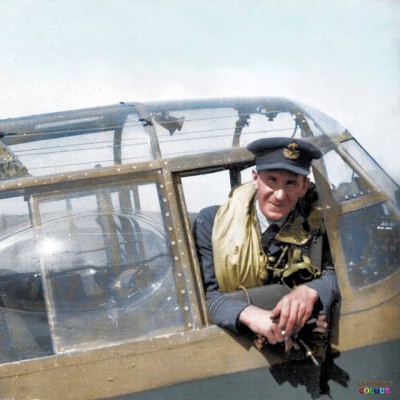
A quick dedication to the last surviving Dambusters pilot, Sqn.Ldr. Les Munro, who has died at the age of 96.
The legendary ‘Dambusters Operation’ of RAF 617 Squadron flew from RAF Scampton, near Lincoln, in 1943 and successfully used “bouncing bombs” to attack German dams. There are now only two surviving crew members of the Dambusters missions.
On the night of 16 May 1943, 19 bombers left RAF Scampton near Lincoln in three waves.
The first headed to the Mohne and the Eder Dams, the second and third to the Sorpe Dam.
Out of the 133 crew that set off, only 77 returned, including Sqn Ldr Munro, who made it home after flak destroyed the internal and external communications in his Lancaster bomber over the Netherlands
He had been briefed to attack the Sorpe Dam by releasing the bomb from the lowest possible height, while flying at 180 mph (290 km/h) The Sorpe Dam was damaged but the Mohne and Eder Dams were destroyed, flooding the Ruhr valley.
(Colourised by Royston Leonard UK) https://www.facebook.com/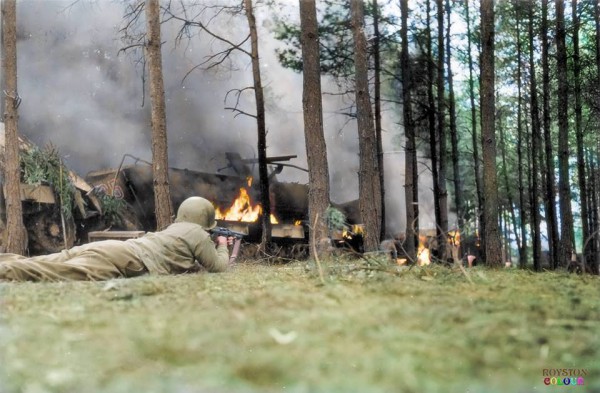
‘Blazing German Convoy’
A Soldier of the 311th Infantry Regiment, 78th Infantry Division, 1st US Army, uses a burning German convoy for shelter as he draws a bead on enemy in the woods near Honnef, Germany. March 1945
(Nb. the burning German transport on the left, appears to be a Sd.Kfz 251 variant) The 311th Infantry Regiment attacked Honnef 10th March 1945.
The 311th Infantry Regiment was attached to the 8th Division in the Hurtgen Forest, 10 December 1944. The 309th and 310th Infantry Regiments relieved elements of the 1st Division in the line in the vicinity of Entenpfuhl, 1-12 December. On the 13th these regiments smashed into Simmerath, Witzerath, and Bickerath and were fighting for Kesternich when Von Rundstedt launched his counteroffensive in the Monschau area, 18 December.
The 78th held the area it had taken from the Siegfried Line against the violent German attacks throughout the winter. The Division attacked, 30 January 1945, and took Kesternich, 2 February, the town of Schmidt on the 8th, and captured intact the vital Schwammanauel Dam the next day. In the advance, the Roer River was crossed, 28 February, and the Division joined the offensive of the First and Ninth Armies toward the Rhine. The river was crossed over the Ludendorff Bridge at Remagen, 8 March, by the 310th Regiment, the first troops to cross in the wake of the 9th Armored Division. That unit, attached to the 9th Armored and acting as a motorized unit had driven across Germany capturing Euskirchen, Rheinbach, and Bad Neuenahr. The 78th expanded the bridgehead, taking Honnef and cutting part of the superhighway, the Autobahn, 16 March. From 2 April to 8 May, the Division was active in the reduction of the Ruhr Pocket and at VE-day was stationed near Marburg.
(history.army.mil)
(Source – ETO HQ 45 24166 March 1945 – US Signal Corps Photos, Photo-G T/4 D. P. Ellett 165)
(Colourised by Royston Leonard UK) https://www.facebook.com/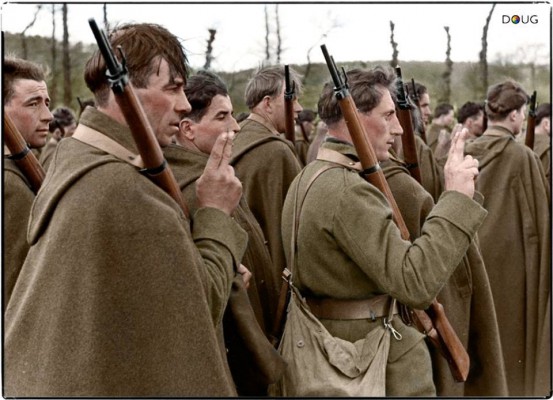
Polish soldiers of the Independent Podhale Rifle Brigade taking the oath in Malestroit, Brittany, France. April 10, 1940.
After the Polish defeat in the Polish September Campaign, the Podhale units were recreated in France as the Polish Independent Highland Brigade, it had seen some action at Narvik, and later fought in the Battle of France and moved into Switzerland upon the French defeat. Some units were also created in the underground as part of the partisan forces of the Armia Krajowa. The traditions of the Podhale Rifles are continued by the modern 21st Podhale Rifles Brigade.
Irish Guards and the crew of an M4 Sherman tank outside of a Texaco Garage in Aalst, Holland.
18 September, 1944,
2nd Armoured Battalion of the Irish Guards, 5th Guards Brigade, Guards Armoured Division, 30 Corps.
The ultimately unsuccessful week-long ‘Operation Market Garden’ commenced on September 17, 1944 with an Allied push toward Germany. The ground portion of the campaign saw the British Guards Armoured Division taking point on the push into the Low Countries.
On the second day of the operation, a column of the Guards Armoured had rolled to the southern outskirts of Aalst in Holland, occupied by German forces since 1940. Led by Col. Joe Vandeleur, the division’s tanks encountered the remnants of German troops and guns which were dug in but heavily-damaged by the previous day’s Allied air bombings and artillery barrages. For the Germans, Aalst was a line in the sand protecting the Allied advance northeast to Antwerp and the Netherlands beyond. For the Allies, keeping the long column of armour moving was key to reinforcing the Allied airborne troops already engaged with German forces along several bridges.
(Colourised by Allan White from Australia) https://www.facebook.com/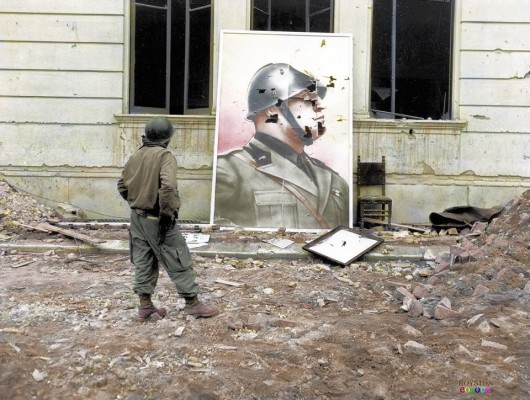
An American soldier looks at a bullet-riddled portrait of the Italian Dictator Benito Mussolini (1883 – 1945) which was taken from the former Fascists political headquarters in Anzio, Italy.7 February 1944.
(Source – MM-5-44-712 U.S. Army Signal Corps photograph, from the collection of The National World War II Museum)
(Collection Level – From the service of Brigadier General Terence John Tully, a West Point graduate, Signal Officer during the African landings, Chief Signal Officer, Allied Force Headquarters Africa/Italy for all Mediterranean operations. Tully served with the Signal Corps in Italy and North Africa documenting the 5th Army specifically. Later he was Commander of Camp Crowder, Missouri).
(Colourised by Royston Leonard UK)
https://www.facebook.com/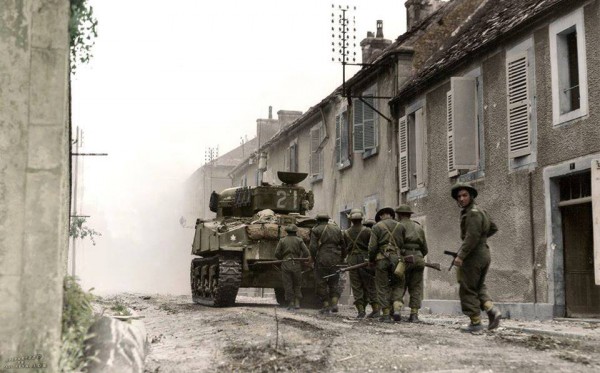
M4A4 Sherman tank No. 21 (possibly S/Nº. T152656 named “Bomb”) of the Sherbrooke Fusiliers Regiment ( 27th Armoured Regiment ), 2nd Canadian Armoured Brigade (Independent ) covers soldiers of the Fusiliers Mont-Royal, 2nd Canadian Infantry Division in Rue des Ursulines in Falaise, Lower Normandy.
August 17, 1944.
(Un char Sherman N°21 du The Sherbrooke Fusiliers Regiment (27th Armoured Regiment) de la 2nd Canadian Armoured Brigade (Independent) couvre les soldats Fusiliers Mont-Royal de la 2nd Canadian Inf.Div. rue des Ursulines à Falaise, le 17 août 1944. Jean-Paul Pallud a retrouvé le lieu, la rue des Ursulines:)
(Colourised by Paul Reynolds from the UK)
https://www.facebook.com/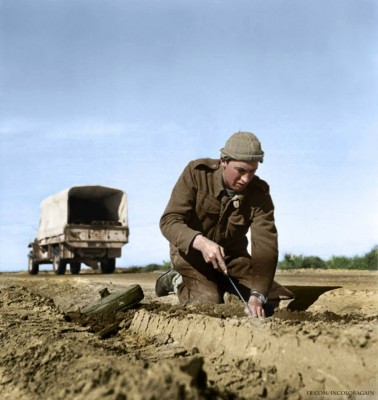
A Sapper from the Royal New Zealand Corps of Engineers probes at the earth in the search for more mines after lifting (digging out) a German Tellermine, near Tripoli, Libya, on the 22d of January, 1943.
(Source – National Library of New Zealand) (Colorized by Noah Werner Winslow)
https://www.facebook.com/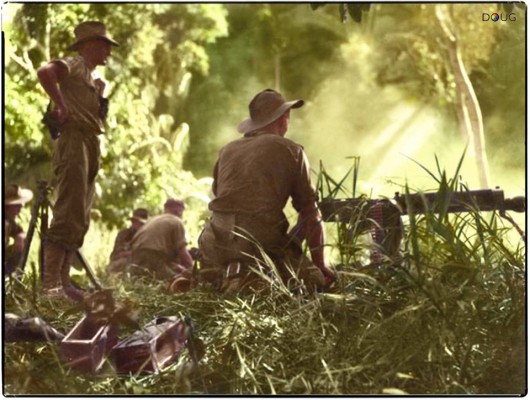
Members of 2 Platoon, B Company, 2/2 Machine Gun Battalion, 26th Brigade (Australia) firing a Vickers .303-caliber MG on a native village across the river which was reported to be housing some 200 Japanese soldiers. Brunei Bay Area, North Borneo. 17th June 1945
Thirty thousands Australians took part in landings at Brunei Bay on 10 and 16 June 1945. The town and airfield of Labuan were captured on the first day but strong Japanese resistance on the island continued until 21 June. In the meantime the Australians were advancing in North Borneo and in Brunei and into Sarawak. There were about 350 Australian casualties, including 114 killed in the campaign.
(Source – Australian War Memorial 109534 – Photographer, Robert Eric Donaldson)
US Marine Jesse Goin carries his dog towards the front, during the Battle of Kwajalein, on the Pacific Marshall Islands. 9 February 1944. The photo was taken by ‘LIFE’ Magazine’s photojournalist George Strock.
Colourised by Tom Marshall at PhotograFix 2015.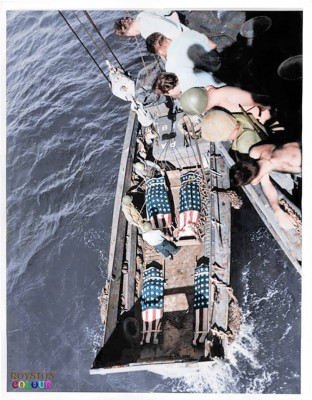
The lowering of the caskets of four 22nd Marines who died of their wounds in the attack on Parry Island in the Eniwetok Atoll. 22nd February 1944.
They are being transported to the nearby Japtan Island for burial in the 22nd Marines Cemetery there.
They were all exhumed during March 1947 and were taken to a Mausoleum at Schofield Barracks, Hawaii for above ground storage in warehouses and eventually casketing operations to be permanently buried in the ‘Punchbowl’ on Oahu, Hawaii or returned to the mainland for burial in a private or national cemetery. (Thanks to Bert Caloud for this information)
(Nb. The ‘Punchbowl’ National Memorial Cemetery of the Pacific is a national cemetery located at Punchbowl Crater in Honolulu, Hawaii) Invasion of Eniwetok Island 18 February 1944
On 18 February 1944, the Amphibious Force under Rear Admiral Harry W. Hill landed troops on Engebi Island, Eniwetok, securing the island before the end of the day. Eniwetok Island was secured on the 21st , with Parry Island secured on the 22nd. The remaining smaller islands of the Atoll were secured on the 23rd.
(Colourised by Royston Leonard UK)
https://www.facebook.com/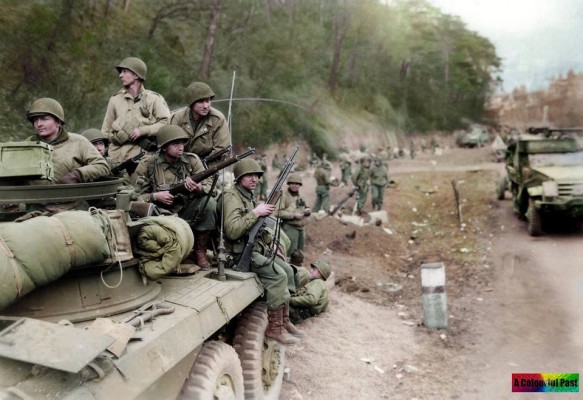
Men of the 328th Infantry Regiment, US 26th Infantry Division riding on an M8 ‘Greyhound’ light armored car of the 735th Tank Battalion near Neustadt, Germany. April 5 1945.
In March ’45 the 328th moved up to the Serrig-Merzig sector for the big push. The push went down along the Saar River, then east to Neustadt. The Rhine was crossed near Mainz. After a bridgehead across the Main River was seized, the regiment took Hanau in a night attack and then moved on towards Fulda.
(Source – NARA File 111-SC-206125, Photographer Pvt. T. R. Romero) (Colourised by Allan White from Australia) https://www.facebook.com/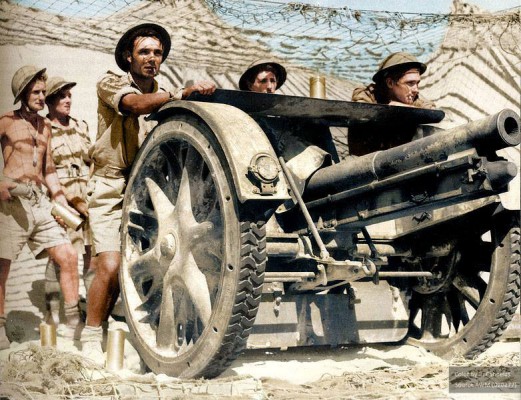
El-Adem Sector, Tobruk, Lybia, August 27, 1941. Men of D Company, 2/17th Infantry Battalion using a captured Italian field gun to send 75mm shells back to their former owners. They were known as the “Bush Artillery” because they were converted infantrymen using captured guns. They came to symbolize the desperate courage, and the resolve of Tobruk’s defenders during the siege of 41.
I’ve found a blog belonging to one of these men’s grandson were he identifies 3 of the men on another photo very similar to this one. By comparing both photos I managed to id (correctly, I hope) the 3 men, so from left to right: 1st soldier unknown, 2nd soldier is NX60436 Pvt. H.E. Zouch, 3rd soldier unknown, 4th soldier is NX65985 Pvt. C.E. Lemaire (later recipient of the Military Medal for bravery in the field for action against the Japanese at Borneo in 1945), 5th soldier was the blogger’s grandfather, NX17811 Pvt. L.J. McCarthy.
When the set to which this photo belongs to was taken by Warrant Officer (later Lt.) Thomas Fisher, official photographer of the 9th Division Military History and Information Section, the gun in question was only 4000 yards from the German front line.
As for the photographer, sadly W.O. Fisher (later Lt. Fisher) was the only photographer of the Military History and Information Section to be killed in action during WW2. Lt. Fisher died in action against the Japanese at Papua on 16th November 1942. He has no known grave.
The gun is an Italian 75mm Cannone da 75/27 modello 06 (Italian version of the German Kanone M1096), one of the oldest artillery pieces to take part in WW2: introduced in 1906, it pre-dates WWI. This gun was an updated model with steel rims with rubber tires instead of the original wooden wheels (although ‘originals’ could also be found in the battlefield).
(Colorisation and Text by Rui Manuel Candeias)
(Colourised by Allan White from Australia) https://www.facebook.com/
M4A2, Sherman Mk III “Cameo” (T146946) tank crew of 2nd Troop, ‘C’ Squadron, 13th-18th Royal Hussars, 27th Armoured Brigade rest and write letters home by the side of their vehicle, Normandy, 10 June 1944.
The 27th Brigade landed at Sword Beach as part of XXX Corps and fought in the Caen area until disbanded on 30 July 1944. They supported the British Commandos’ breakout from the Normandy Landings. Later supported the British Paratroopers at Breville. On 11 June a squadron of 13/18th Hussars supported 6th Airborne Division’s attacks along the river, and later in the month the regiment supported 51st (Highland) Infantry Division in further attacks along the river. On 8 & 9 July, 27th Armoured Bde supported I Corps’ final successful attack on Caen.
13th/18th Hussars (Transferred to 8 Armoured Brigade 30 July) (Initially Sherman II DD, later Sherman III & Firefly VC)
(Colourised by Allan White from Australia) https://www.facebook.com/AColourfulPastRevisited
German soldiers gather around a French Gnome et Rhône AX2 800 motorcycle and side car in Belgorod, Russia. Summer 1943.
On 23 Jul 1943, following the victory at Kursk, Russia, the Soviet forces launched Operation Polkovodets Rumyantsev, the first phase of which, named the Belgorod-Bogodukhov Offensive Operation, aimed at capturing the city of Belgorod. On 3 Aug, troops of Soviet Voronezh Front and Steppe Front crossed the Vorskla River and penetrated German lines manned by the 332nd Infantry Division, the 167th Infantry Division, and the 19th panzer Division near Belgorod, Russia. Two days later, the 60,000 German troops and 250 tanks in the city evacuated to prevent envelopment. In the week of fierce fighting that followed, the Soviets enjoyed a tremendous numerical advantage with over 400,000 men and 1,800 tanks. When the Germans broke out of the area, they had lost about 20,000 killed; the Soviets suffered 50,000 killed and 800 tanks destroyed in this costly victory.
(ww2db.com)
The Gnome et Rhône AX2 800. An 800cc boxer with 2-wheel drive production of these bikes started in 1940 for the French army but the Germans took over the factory and used the bikes for their own Wehrmacht.
Gnome & Rhone and also the Terrot company produced the model AX2 for the German Wehrmacht until 1944. 21./Panzer Division was supplied with about 100 of them in early 1944 and they were used on the invasion front against the British army.
(Trivia – in recent years, a Gnome et Rhône, mod. AX2, 1939, 800cc, sidecar, complete bike for restoration, with documentation sold for 18.000€)
(Colourised by Doug)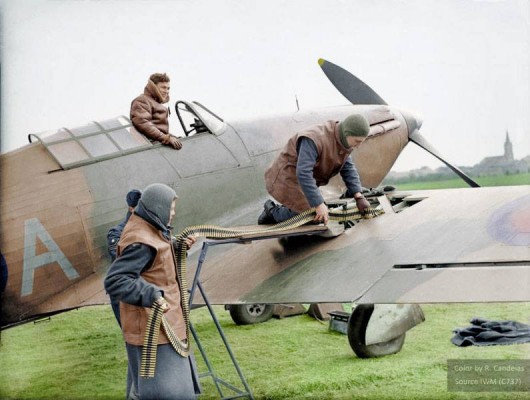 Rouvres airfield, France, winter of 1939/40. On a cold, misty day, Sergeant T. B. G. ‘Titch’ Pyne, a British pilot serving with 73 Squadron, smiles as he watches two armourers rearming the .303 Browning MGs of his Hawker Hurricane Mk I.
Rouvres airfield, France, winter of 1939/40. On a cold, misty day, Sergeant T. B. G. ‘Titch’ Pyne, a British pilot serving with 73 Squadron, smiles as he watches two armourers rearming the .303 Browning MGs of his Hawker Hurricane Mk I.
While on the ground the ‘Phony War’ gave a false sense of inactivity, in the skies daily battles were fought between the Allied and German air forces.
Sgt ‘Titch’ Pyne flew his first mission on the 26th of March 1940 as part of Green Section, Flight B. Soon after crossing the German border (despite express orders not to), Sgt Pyne, his mate Flg Off J. G. ‘Tub’ Perry, and their section leader, a Kiwi by the name of James ‘Cobber’ Cain, spotted nine Bf 109Es of III./JG53 ‘Pik As’. Although outnumbered 3 to 1, ‘Cobber’ Cain took advantage of his higher altitude to jump the German aircrafts and soon enough one of the two Bf109 he shot during that action fell away trailing smoke and flames. Pyne and Perry had also chosen their targets and followed their leader into the fray, but being inexperienced, both quickly expended their ammo and were forced to return home. Perry was later credited with a Bf109E destroyed while Pyne’s claim was rated as only a probable. Although being shot down himself, the two confirmed kills that day made of James ‘Cobber’ Cain the first allied ace of the war. J. G. ‘Tub’ Perry was shot down and killed three days later.
As for Sgt Pyne, he was shot down the first time on April 23rd 1940 when his squadron was surprised by Bf109s of III./JG53 west of Merzig. Wounded in a shoulder and with his Hurricane (N2391) badly damaged by the BF109 of Fw Gawlick, Sgt Pyne made a force-landing near Sierck-les-Bains at 10.30 a.m. Minutes before, at 10.14 a.m., one of his squadron mates had been shot down by a soon to be famous Hptmn Mölders of III./JG53 in what was Mölders’ 9th WW2 victory.
After recovering from his injuries, Sgt Pyne went back to flying combat missions until the 14th of May 1940, when his Hurricane (N2856) was shot down by Bf110s of III./ZG26 and crashed in the Bois de Voncq, north of Vouziers at 12.25 p.m. It is believed that Sgt Pyne managed to bail out but was killed (unspecified causes). He now rests at Choloy War Cemetery.
This photo offers a good example of an early production Hawker Hurricane Mk I with ‘kidney’ shaped exhaust stacks and a Watts wooden propeller.
Source IWM (C737)
